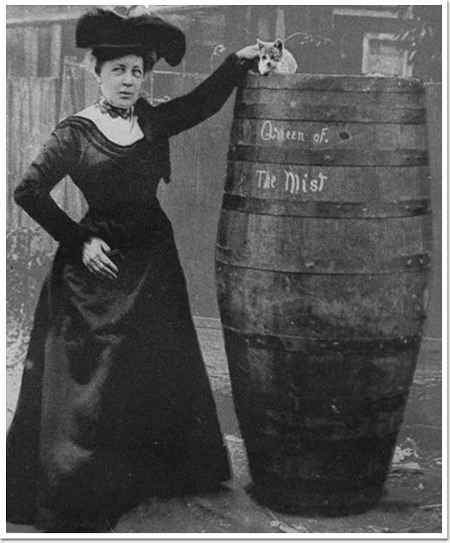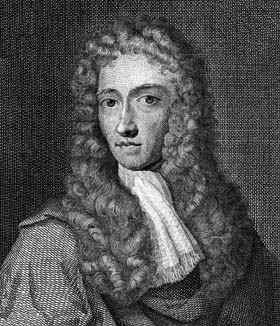Anna Edson Taylor, a 43-year-old widow, was the first woman to go safely over Niagara Falls in a barrel. The barrel was four and a half feet high and three feet across. Ms. Taylor went over Niagara Falls and dropped 175 feet.
 The barrel was four and a half feet high and three feet across.She made the attempt for the cash award offered, which she put toward the loan on her Texas ranch and help her make a fortune touring the world. Although the stunt did indeed receive international attention, Taylor will reap few financial rewards, and die in poverty after twenty years as a Niagara street vendor
The barrel was four and a half feet high and three feet across.She made the attempt for the cash award offered, which she put toward the loan on her Texas ranch and help her make a fortune touring the world. Although the stunt did indeed receive international attention, Taylor will reap few financial rewards, and die in poverty after twenty years as a Niagara street vendorIt's National Bologna Day
When was the last time you had a Baloney sandwich
Just don't ask how they make it.
October 24, 1973 -
The series about bald, dapper, New York City policeman , Kojak, starring Telly Savalas, premiered on CBS-TV on this date.
Telly Savalas is seen throughout the series both sucking on his lollipop and smoking. The lollipop was used to cut back on smoking. His character Kojak even admitted once that he smoked too much and sucked on lollipops every day except on Sundays.
Today in History:
October 24, 1601 -
Tycho Brahe, nobleman, astronomer and alchemist, died from politeness on this date. He was fabulously weathly and had a dwaft court jester sit under the table at dinner to amuse him. Tycho lost his nose in a duel and had a metal one made which he famously wore for the rest of his life. He also had a pet moose, who died from a drunken fall (I can't make this stuff up.)
 Brahe went to a party at a friend’s house and drank heavily, bound by the etiquette of the day, Tycho couldn’t leave the table until his host did -not even to go to the bathroom. When he finally left the table he found he could not go; his bladder was blocked from waiting too long. He lingered for days in utter agony for days until he died on this date.
Brahe went to a party at a friend’s house and drank heavily, bound by the etiquette of the day, Tycho couldn’t leave the table until his host did -not even to go to the bathroom. When he finally left the table he found he could not go; his bladder was blocked from waiting too long. He lingered for days in utter agony for days until he died on this date.Traditionally it’s believed he died from urine poisoning. Recent analysis of hair taken from his remains shows that he must have ingested a large dose of mercury about 20 hours before his death, possibly as a medicine for his illness or perhaps he was poisoned - some believe by his famous student Johannes Kepler, who worked for him at the time and was appointed his successor as imperial mathematician.
October 24, 1836 -
(Please follow along on your flow charts) Mankind was not fully mankind until it learned how to set things on fire. That happened a long time ago and enabled such hallmarks of early civilization as cooked meat, heated homes, and flaming heretics. Only in the past few hundred years has mankind learned how to start fires quickly and easily.
In 1680, Irish scientist Robert Boyle discovered that rubbing phosphorus and sulphur together caused them to burst into flames. Such was his reward for a lifetime spent rubbing phosphorus against things to see what would happen.
 In 1827, seizing upon the Irish invention with a zeal usually reserved for Irish real estate, an Englishman named John Walker invented "sulphuretted peroxide strikeables," which were like matches except they were three feet long and as likely to explode as ignite.
In 1827, seizing upon the Irish invention with a zeal usually reserved for Irish real estate, an Englishman named John Walker invented "sulphuretted peroxide strikeables," which were like matches except they were three feet long and as likely to explode as ignite. A variation on this firestarter was introduced in England in 1828, patented by Samuel Jones. It was called the Promethean, and consisted of a glass bulb of sulphuric acid. The bulb was coated with potassium chlorate, sugar, and gum, then wrapped in paper. To ignite the Promethean, one broke the glass bulb against one's teeth. Dentists loved it, but the public remained wary.
A variation on this firestarter was introduced in England in 1828, patented by Samuel Jones. It was called the Promethean, and consisted of a glass bulb of sulphuric acid. The bulb was coated with potassium chlorate, sugar, and gum, then wrapped in paper. To ignite the Promethean, one broke the glass bulb against one's teeth. Dentists loved it, but the public remained wary.Finally, on this date, a patent was issued in the United States to Alonzo D. Phillips for the manufacture of friction matches and called them locofocos.
October 24, 1929 -
The stock market began a catastrophic collapse and this day became know as Black Thursday nearly 13 million shares traded hands and stock prices plummeted.
This ultimately led to the Great Depression. Scientists around the world desperately sought a cure for the millions of Depressed peoples on every continent. Researchers from the National Socialist Society eventually demonstrated that the people of Germany, Italy, and Spain were Depressed because their trains didn't run on time, and fascism was invented to address this shortcoming.
Having resolved their train schedules, however, fascists discovered that many people were still unhappy. This was found to have been the result of socialism (remember, National Socialist are not Socialists i.e. Communist), which was incompatible with fascism, and persons who failed to become happy were subsequently shot.
This caused the Spanish Civil War, which was so successful it inspired World War II, after which everyone felt much better.
October 24, 1931 -
The George Washington Bridge opens to public traffic, linking New York City with New Jersey. The bridge became a famous New York landmark and has been featured in many movies and TV shows. The toll to cross the bridge was to be temporary -- just to cover costs.
 But it costs and costs and costs when you have to keep repairing and painting a bridge that big -- so, the bridge toll continues. And the bridge is still being painted.
But it costs and costs and costs when you have to keep repairing and painting a bridge that big -- so, the bridge toll continues. And the bridge is still being painted.October 24, 1947 -
In a very UN-American fashion, Neo-Nazi and American Isolationist Walt Disney testified to the House Unamerican Activities Committee on this date.
Disney named employees he believes to be Communists, ranting about how Communists were infiltrating the unions he has to deal with, and how "Commie groups began smear campaigns against [him]."
October 24, 1960 -
At the Soviet Union's Baykonur space facility, an R-16 ballistic missile explodes on the launch pad, incinerating 165 people on this date.
Included among the dead is Field Marshall Mitrofan Nedelin, whose death is covered up as having occurred in a plane crash.
October 24, 1962 -
A taut thriller with the underlying theme of an afternoon tea party gone horribly wrong - The Manchurian Candidate, premiered on this date.
In the scene where Frank Sinatra gives the all-queens deck of cards to Laurence Harvey, Sinatra is out of focus. He had trouble recreating his performance, so director John Frankenheimer left the footage as is. Audiences weren't bothered; they interpreted it as Harvey's blurred perspective.
October 24, 1969 -
The original version of Brokeback Mountain, Butch Cassidy and the Sundance Kid, premiered on this date.
The movie was filmed roughly the same time as Hello, Dolly!, on the sound stage next door. Director George Roy Hill believed that the studio would allow him to film the New York scenes on "Dolly's" sets, since the two films' daily shooting schedules were totally different. After production started, though, the studio informed him that it wanted to keep the sets for "Dolly" a secret and so refused him permission. To work around this, Hill had Robert Redford, Paul Newman and Katharine Ross simply pose on the sets and took photos of them. He then inserted images of the three stars into a series of 300 actual period photos and spliced the two different sets (real and posed) together to form the New York montage.
And so it goes
No comments:
Post a Comment